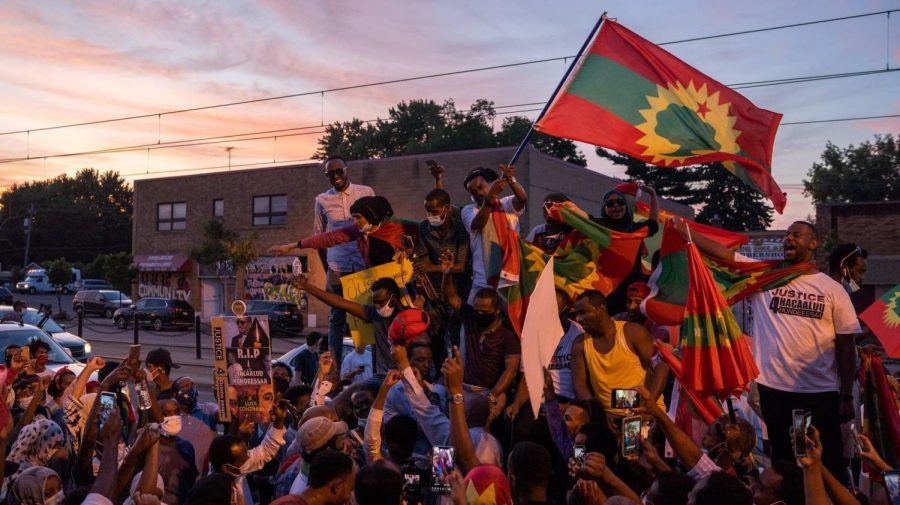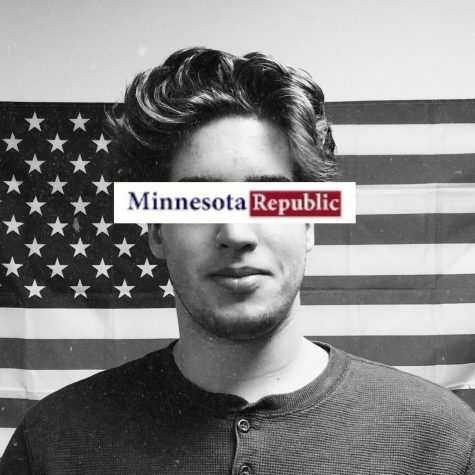The Social Dilemma For Representation in Oromia
October 21, 2020
An international issue stemming far from home was brought to the Twin Cities’ doorstep. Minnesota has the largest Somali population in the United States as well as many other immigrants from surrounding East-African countries; Ethiopia being the dominant one. In July, protests broke out around the capitol building, bringing to attention the killing of Oromo-Ethiopian musician/activist Hachalu Hundessa back in Addis Ababa, Ethiopia. But this protest is only the tip of the iceberg of a centuries old conflict deeply rooted in Ethiopian ethnic issues and identity politics.
Ethiopia-located inland on the horn of Africa-is comprised of many languages and ethnicities, mainly of the Oromo, Amhara, Tigray, and Somali people. I cannot, nor do I feel comfortable speaking on the genesis of the ethnic issues in Ethiopia, but I can shine the light more generally on what the struggle is.
It’s crazy to see history repeat itself and for parallels to be drawn across so many kinds of people and places. Rwanda went through something similar in that they had two main types of people; Hutus and Tutsis. One had more representation in government and better treatment and rights in society which lead to struggles and ultimately a genocide.
So, this happened in Rwanda, what does this have to do with Ethiopia?
The Oromo people make up for approximately 35% of Ethiopia, while the Amhara people equal about 25%. Like what we saw in Rwanda, the Amhara people are generally seen as higher class, inner city people. The Oromo people can be more generally regarded as “country-folk”. Oromos, though holding a lot of major government positions, feel disenfranchised. There is a large correlation between Islam and the Oromo people, and mosques and churches have been used as collateral on both sides.
Hachalu Hundessa held the number one selling album for African music on Amazon Music. His music was widely used to express the oppression felt by the Oromo people, encouraging them to band together and resist. Hachalu died due to gunshots this past July. Hachalu’s platform and voice was mainly through social media and technology, which contributed to the outcry in wake of his death. A lot of speculation towards his death caused young people on social media to lash out and get violent.
I tapped in with a good Oromo friend of mine, Nuubeek. He provided some incredibly insightful and interesting comparisons between the explosion of anger that followed both Hachalu Hundessa and George Floyd’s deaths, both occurring around the same time. He explained that this has been an issue for a long time, but not on this scale. Oddly enough, just like in the George Floyd situation, social media acted as a huge catalyst for the reaction to the death.
He drew similarities between politics in a third world country like Ethiopia to the United States. Politics are incredibly polarized, and there is no middle ground on situations like this. You are forced to pick a side, which ultimately causes sentiments to grow and pushes people further and further apart. Hachalu was promoting Oromo rights and treatment and to many was seen as a martyr for his death. Hundessa’s killing sparked many protests and riots in Ethiopia leading to several hundred dead and many injured.
He recommended me to watch the Netflix documentary The Social Dilemma. Tech companies can so easily predict people and their reactions and take advantage of the many young users of their applications to push an agenda. A very recent and relevant example of that here is George Floyd. Literally within a day, everybody and their mother was fired up about what they saw and read. Social media is a huge, powerful tool, and affects people the same on different continents. Social media allows people to see headlines and immediately form an opinion, and it’s happening in Africa too. The social media outcries throughout Ethiopia were cause for internet blackouts put in place throughout the country, which had been previously used before as a tactic to suppress unrest. It’s interesting to see Africa using social media for political reasons as predominantly as we do in the western world, only for it to be censored because it was too powerful. The exposure and attention that social media brought to what was happening in Ethiopia was incredibly fast and effective which contributed a lot to the violence that happened as groups on both side mobilized and committed atrocious acts.
Nuubeek left me to contemplate by saying that even though there exist thousands of miles between the two places of violence and unrest, the astounding similarities show how easily people can form opinions through social media; polarizing people further than ever before.
That’s not to say that the world, America included, doesn’t have anything to work on, but social media doesn’t represent the silent majority. We need to take a step back and evaluate the affect that social media has on our feelings and perception of the world. Unfortunately, the prospective of ethnic tension in Ethiopia doesn’t look to be resolved any time soon but it is important to recognize that what is happening in America is happening all over the world, and social media does a really good job of fanning the fire. Obviously, there is a lot more to this conflict than what can be summarized in a short article.
More importantly, oppression is alive and well and should be seriously considered as the people of Oromia struggle for equal treatment and rights.
*This article has been updated and republished as of Oct. 22. After further review, some information was found to be incorrect. This article now reflects those changes.














Jawar • Nov 8, 2020 at 10:39 pm
to the comment above saying “Amhara are richer,” what are you smoking?
most Amhara are one of the poorest people in ethiopia because their land is dry like Tigray.
Oromo land is fertile and our farmers are better off than Amharas. The fact 5% of Amhara live in cities as majorities does not mean most Amhara are richer than Oromo.
they are NOT
Gabra • Oct 29, 2020 at 9:54 am
Hello can anyone explain me what is going on in Ethiopia please, but with proof. Because i heard everything and anything on that. Thank you
Sarah • Oct 22, 2020 at 2:13 pm
Good article! Except you forgot to add Amhara’s are not in power. The central government (president included) are Oromo. But yeah it is true Amhara are generally richer and live in the urban areas.
Teshome • Oct 22, 2020 at 12:09 pm
Jaden, what are you talking about? You have been misinformed! The Oromo are in complete power in Ethiopia. Some just don’t like the kind of Oromo that is in power. Oromo is not monolithic—many have allegiances to many different Oromo groups. They have never, ever had even similar views. The rest of Ethiopia has willingly supported their holding power despite the fact that the Oromo wish to impose a system known as Geda—a paternalistic form of society that is also unfamiliar to modern laws, cultures and norms. Your article, while not fictional, is short on facts. You may wish yo learn a bit more, my friend. Stay safe.
Jamal • Oct 22, 2020 at 10:38 am
Jadan,
I think you should check your facts before you getting hoodwinked by Nebeek, Oromo friend. Hachalu was a nationalist and he was killed by Oromos for not being ethnonationalist or for not pushing only Oromo agenda. He was killed to incite violence by OLF and supporters like Nebeek to create Rwanda like situation by claiming that he was kiilled by Amharas or the government.
Using social media, they told the Oromo youth that Hachalu was killed by Amharas or the government and the Oromo youth retaliated by beheading children, women, old and young people merely for being a different ethnic group. They looted and burned every church, business owned by non-Oromos. This is the real story.
As far as comparing it with George Floyd situation belies lack of research in your part. The Oromos in Ethiopia control all level of government including the Office of the Prime Mininster. Only Oromo fanatics are behaving likef David Duke in America or Boko Haram in Nigeria, they are kidnapping university students, robbing banks, killing non-Oromos and other Oromos because they want to create an indepdent Oromo or want to drive evey other Ethiopians from Ethiopoia. These are simply irrational people an power hungry fanatics.
I hope next time you interview more Ethiopians to avoid such flagrant disregard for the truth and good journalism.
Araari O. • Oct 22, 2020 at 6:01 am
Wow! An entire article based on words of one Oromo friend in Minnesota, and no mention of Jawar Mohammed.
UN reported over 1.5 million non-Oromos in 2018 were displace by Oromo attackers seeking an independent Oromia. Ethiopia’s leadership today is run by Oromos, including Prime Minister, Defense Minister, etc, etc…Not Amharas, not for decades!
Minnesota’s Jawar Mohammed was finally arrested and jailed in Ethiopia for causing ethnic unrest and slaughter of countless non-Oromos (and Hachalu’s death), cue protests by Muslim Oromos in MN. The battle is between Oromos themselves, Jawar’s group of Muslim Oromo rebels pitted against Christian Oromos like singer Hachalu and the Prime Minister, Abiy, an evangelical Christian.